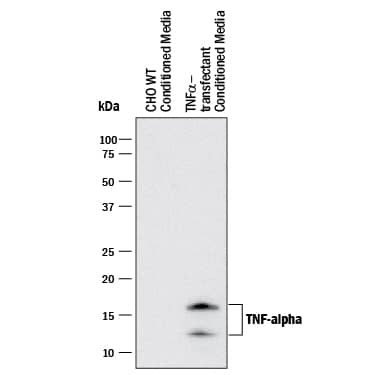Human TNF-alpha Antibody
R&D Systems, part of Bio-Techne | Catalog # MAB2102

Key Product Details
Species Reactivity
Validated:
Human
Cited:
Mouse
Applications
Validated:
Immunocytochemistry, Western Blot
Cited:
Functional Assay
Label
Unconjugated
Antibody Source
Monoclonal Mouse IgG2B Clone # 983003
Product Specifications
Immunogen
E. coli-derived recombinant human TNF‑ alpha
Lys87-Ala232
Accession # P01375
Lys87-Ala232
Accession # P01375
Specificity
Detects human TNF‑ alpha in direct ELISAs.
Clonality
Monoclonal
Host
Mouse
Isotype
IgG2B
Scientific Data Images for Human TNF-alpha Antibody
Detection of Human TNF‑ alpha by Western Blot.
Western blot shows conditioned media from CHO Chinese hamster ovary cell line either mock transfected or transfected with human TNF- a. PVDF membrane was probed with 1 µg/mL of Mouse Anti-Human TNF-a Monoclonal Antibody (Catalog # MAB2102) followed by HRP-conjugated Anti-Mouse IgG Secondary Antibody (Catalog # HAF018). Specific bands were detected for TNF-a at approximately 13 and 16 kDa (as indicated). This experiment was conducted under reducing conditions and using Immunoblot Buffer Group 1.TNF‑ alpha in Human PBMCs.
TNF-a was detected in immersion fixed human peripheral blood mononuclear cells (PBMCs) using Mouse Anti-Human TNF-a Monoclonal Antibody (Catalog # MAB2102) at 8 µg/mL for 3 hours at room temperature. Cells were stained using the NorthernLights™ 557-conjugated Anti-Mouse IgG Secondary Antibody (red; Catalog # NL007) and counterstained with DAPI (blue). Specific staining was localized to cytoplasm. View our protocol for Fluorescent ICC Staining of Non-adherent Cells.Applications for Human TNF-alpha Antibody
Application
Recommended Usage
Immunocytochemistry
8-25 µg/mL
Sample:
Sample:
Immersion fixed human peripheral blood mononuclear cells (PBMCs)
Western Blot
1 µg/mL
Sample: CHO Chinese hamster ovary cell line eith transfected with human TNF-alpha
Sample: CHO Chinese hamster ovary cell line eith transfected with human TNF-alpha
Formulation, Preparation, and Storage
Purification
Protein A or G purified from ascites
Reconstitution
Reconstitute at 0.5 mg/mL in sterile PBS. For liquid material, refer to CoA for concentration.
Formulation
Lyophilized from a 0.2 μm filtered solution in PBS with Trehalose. *Small pack size (SP) is supplied either lyophilized or as a 0.2 µm filtered solution in PBS.
Shipping
Lyophilized product is shipped at ambient temperature. Liquid small pack size (-SP) is shipped with polar packs. Upon receipt, store immediately at the temperature recommended below.
Stability & Storage
Use a manual defrost freezer and avoid repeated freeze-thaw cycles.
- 12 months from date of receipt, -20 to -70 °C as supplied.
- 1 month, 2 to 8 °C under sterile conditions after reconstitution.
- 6 months, -20 to -70 °C under sterile conditions after reconstitution.
Background: TNF-alpha
Long Name
Tumor Necrosis Factor alpha
Alternate Names
Cachetin, DIF, TNF, TNF-A, TNFA, TNFalpha, TNFG1F, TNFSF1A, TNFSF2
Entrez Gene IDs
Gene Symbol
TNF
UniProt
Additional TNF-alpha Products
Product Documents for Human TNF-alpha Antibody
Product Specific Notices for Human TNF-alpha Antibody
For research use only
